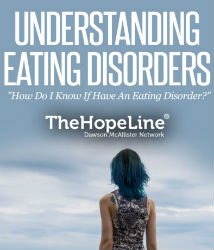Eating Disorders in General
What is an eating disorder?
The simple answer:
An eating disorder is present when a person:
- is constantly thinking about eating or not eating
- feels out of control around food uses food to meet needs other than hunger
- becomes obsessed about food, weight and body shape
A person can be any size and have an eating disorder.
And in more detail:
An eating disorder is a mental illness. However, unlike most mental illnesses they have a strong physical component and the effects of the eating disorder can have serious consequences on the body. Having a mental illness does not mean you will always have it, people can and do recover from eating disorders. What is most important with an eating disorder is not so much what is happening, but why it is happening.
Eating disorders are very complex. Neither the causes of the eating disorder or the effects are the same for everybody and for most people there are many causes and many effects.
Eating disorders are often a way of managing emotional distress and coping with life’s demands.
It can be useful to look at an eating disorder as made up of three parts: food, body image and control.
Eating disorders are seldom black or white. It’s a matter of degree. Eating disorders exist on a continuum along with poor body image and dieting.
There are three main types of eating disorders. These are anorexia, bulimia and compulsive eating. However many eating disorders do not exactly fit into these three categories. Every person’s pattern and experience of an eating problem is unique.
Anorexia:
Anorexia exists when a person severely cuts down the amount of food they eat. They might experience dramatic weight loss which can be life threatening, while still believing they need to lose more. They may also vomit (but not binge).
People with anorexia may:
- be very thin
- deny being ill
- be obsessed with food
Bulimia:
Bulimia exists when a person eats large amounts of food in a way that feels out of control then compensates by vomiting, starving, exercising or using laxatives. The person may not change in size or shape.
People with bulimia may:
- be of ‘normal weight’
- be very secretive
- often go the bathroom after eating
Compulsive Eating:
Compulsive eating is eating large quantities of food (either at one time or over a day) and feeling out of control. This is usually followed by feelings of guilt and shame. This may alternate with periods of dieting or constant attempts to diet.
People who compulsively eat may:
- feel guilty about eating
- be out of control
- want it to stop
Often people with an eating disorder do not acknowledge or accept that they have a problem. We often think it’s normal to worry about our weight or even to diet. However an eating disorder is more than just worrying about the way we look or wanting to get healthy. It can be very distressing for the person, both physically and emotionally.








Recent Comments